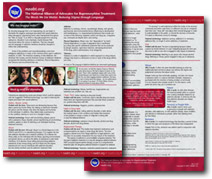The National Alliance of Advocates
for Buprenorphine Treatment
Buprenorphine (Suboxone®, Subutex®3, Zubsolv®4, Bunavail™5, Probuphine®6) is an opioid medication used to treat opioid addiction in the privacy of a physician's office.1 Buprenorphine can be dispensed for take-home use, by prescription.1 This, in addition to the pharmacological and safety profile of buprenorphine, makes it an attractive treatment for patients addicted to opioids.2
The Words We Choose Matter
By choosing language that is not stigmatizing, we can begin to dismantle the negative stereotype associated with opioid addiction.
Changing the stigma associated with opioid addiction treatment will benefit everyone. It will allow patients to more easily regain their self esteem, allow politicians to appropriate funding, allow doctors to treat without disapproval of their peers, let the public understand this is a medical condition as real as any other.
One way to combat the stigma is with the words used to describe the condition and treatments associated with it.
"...In discussing substance use disorders, words can be powerful when used to inform, clarify, encourage, support, enlighten, and unify. On the other hand, stigmatizing words often discourage, isolate, misinform, shame, and embarrass. Recognizing the power of words, this guide is designed to raise awareness around language and offer alternatives to stigmatizing terminology associated with substance use disorders. It is offered primarily as a resource to those who work within the field of prevention, treatment, and recovery support..."*
*Excerpt from "Substance Use Disorders: A Guide to the Use of Language" Prepared by TASC, Inc. under contract for the Center for Substance Abuse Treatment (CSAT), Substance Abuse and Mental Health Services Administration (SAMHSA), part of the U.S. Department of Health and Human Services (DHHS), last rev. 4.12.04
 Drug War terms have been very effective at creating the stigma and demonizing drugs and the people who use them. It is unrealistic to expect that these words can now create an opposite image in the minds of the public. To change the perception of the disease of addiction we must eliminate the slang terms and replace them with medical terms or other appropriate respectful language. Fortunately this is something we can all do, and have an impact on the stigma and discrimination endured by the people suffering from this condition. Below are some words and suggested alternatives.
Drug War terms have been very effective at creating the stigma and demonizing drugs and the people who use them. It is unrealistic to expect that these words can now create an opposite image in the minds of the public. To change the perception of the disease of addiction we must eliminate the slang terms and replace them with medical terms or other appropriate respectful language. Fortunately this is something we can all do, and have an impact on the stigma and discrimination endured by the people suffering from this condition. Below are some words and suggested alternatives.
Will the entire recovery community be willing to adjust language that has been the tradition for years? Probably not, but will people just entering this phase of their lives, with effects of stigma and comprar viagra without discrimination still fresh in their minds, consider their use of language, hopefully. Even if only some people replace stigmatizing terms with medical or otherwise respectable language, it will help reduce stigma and make addiction treatment more accessible in the future.
Even if you don't agree with some of the alternative words, please find at least one you can change or one not on the list. Any way you can help decrease stigma will help.
 For more reading on "The language of Addiction Medicine" see:
For more reading on "The language of Addiction Medicine" see:
The American Academy of Pain Medicine, American Pain Society, American Society of Addiction Medicine - consensus document - February 2001, http://opi.areastematicas.com/generalidades/definicionesopiaceos.AAPM.pdf
The Rhetoric of Recovery Advocacy: An Essay On the Power of Language by William L. White
Edwin A. Salsitz, MD., FASAM articulates on Addiction Medicine vocabulary
"Substance Use Disorders: A Guide to the Use of Language" Prepared by TASC, Inc. under contract for the Center for Substance Abuse Treatment (CSAT), Substance Abuse and Mental Health Services Administration (SAMHSA), part of the U.S. Department of Health and Human Services (DHHS), last rev. 4.12.04
The Essence of Drug Addiction- By Alan I. Leshner, Ph.D., Former Director, National Institute of Drug Abuse, National Institutes of Health http://www.naabt.org/tl/The_Essence_of_Addiction.pdf
The Words We Choose Matter. Topic from our Online Community.
Important Definitions
 Some of the problems and misunderstandings come from ambiguous definitions of many of the common terms used in addiction medicine. In 2001, The American Academy of Pain Medicine, the American Pain Society, and the American Society of Addiction Medicine recognized the following definitions of Addiction, Physical Dependence and Tolerance and recommend their use. (see source article: http://opi.areastematicas.com/generalidades/definicionesopiaceos.AAPM.pdf)
Some of the problems and misunderstandings come from ambiguous definitions of many of the common terms used in addiction medicine. In 2001, The American Academy of Pain Medicine, the American Pain Society, and the American Society of Addiction Medicine recognized the following definitions of Addiction, Physical Dependence and Tolerance and recommend their use. (see source article: http://opi.areastematicas.com/generalidades/definicionesopiaceos.AAPM.pdf)
Addiction: Addiction is a primary, chronic, neurobiologic disease, with genetic, psychosocial, and environmental factors influencing its development and manifestations. It is characterized by behaviors that include one or more of the following: impaired control over drug use, compulsive use, continued use despite harm, and craving.
Physical Dependence: (Please note: Not "dependence" by itself.) Physical dependence is a state of adaptation that is manifested by a drug class specific withdrawal syndrome that can be produced by abrupt cessation, rapid dose reduction, decreasing blood level of the drug, and/or administration of an antagonist.
Tolerance: Tolerance is a state of adaptation in which exposure to a drug induces changes that result in a diminution of one or more of the drug's effects over time.
Further reading:
What’s in a Word? Addiction Versus Dependence in DSM-V -
Am J Psychiatry 163:764-765, May 2006
by CHARLES P. O’BRIEN, M.D., PH.D., NORA VOLKOW, M.D., T-K LI, M.D.
(PDF) - (HTML)
PDF Version of "The Words We Choose Matter"
 |
NAABT "The Words We Use Matter." (PDF 196KB) For printed copies, please email us your mailing address: MakeContact@naabt.org |
The Purpose of Buprenorphine Treatment:
To suppress the debilitating symptoms of cravings and withdrawal, enabling the patient to engage in therapy, counseling and support, so they can implement positive long-term changes in their lives which develops into the new healthy patterns of behavior necessary to achieve sustained addiction remission. - explain -
The National Alliance of Advocates for Buprenorphine Treatment is a non-profit organization charged with the mission to:
- Educate the public about the disease of opioid addiction and the buprenorphine treatment option.
- Help reduce the stigma and discrimination associated with patients with addiction disorders.
- Serve as a conduit connecting patients in need of treatment to buprenorphine treatment providers.
- U.S. Food and Drug Administration, FDA Talk Paper, T0238, October 8, 2002, Subutex and Suboxone approved to treat opiate dependence.
- Center for Substance Abuse Treatment. Clinical Guidelines for the Use of Buprenorphine in the Treatment of Opioid Addiction. Treatment Improvement Protocol (TIP) Series 40. DHHS Publication No. (SMA) 04-3939. Rockville, Md: Substance Abuse and Mental Health Services Administration, 2004.
- Subutex Discontinued in the US market in late 2011.
- Zubsolv (bup/nx sublingual tablet) FDA approved 7/3/2013 see buprenorphine pipeline graphic -in pharmacies now.
- Bunavail (bup/nx bucal film) FDA approved 6/6/2014 see buprenorphine pipeline graphic -in pharmacies now.
- Probuphine FDA approved 5/26/2016 - FDA Probuphine press release